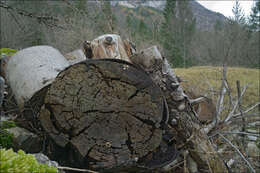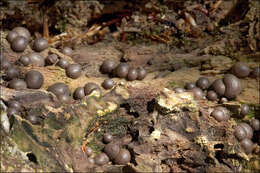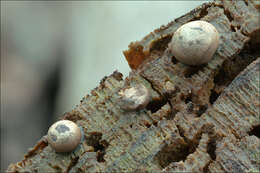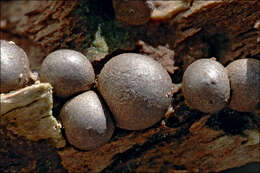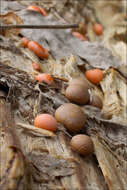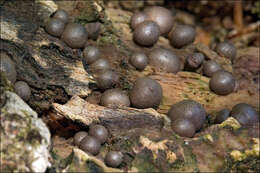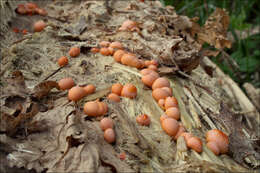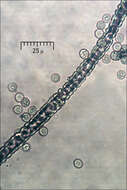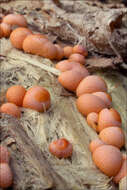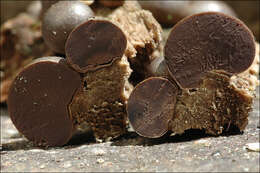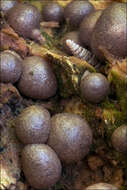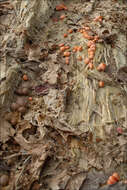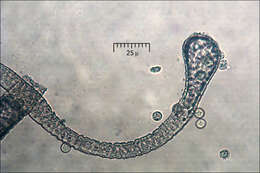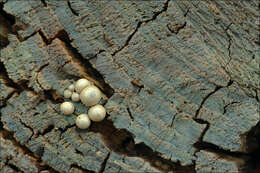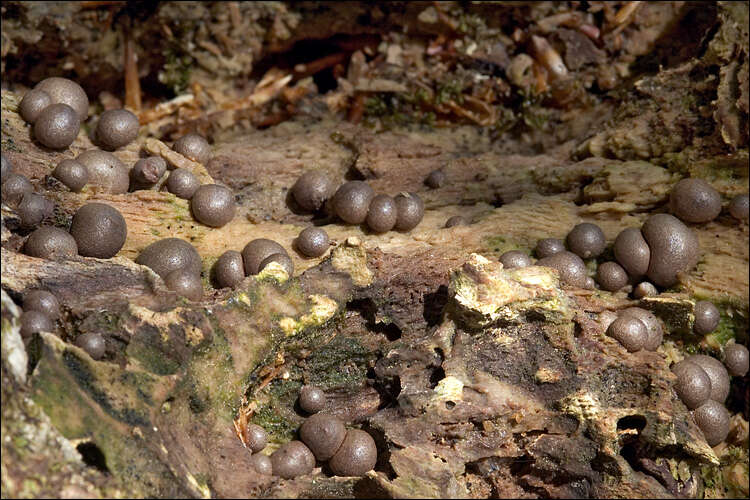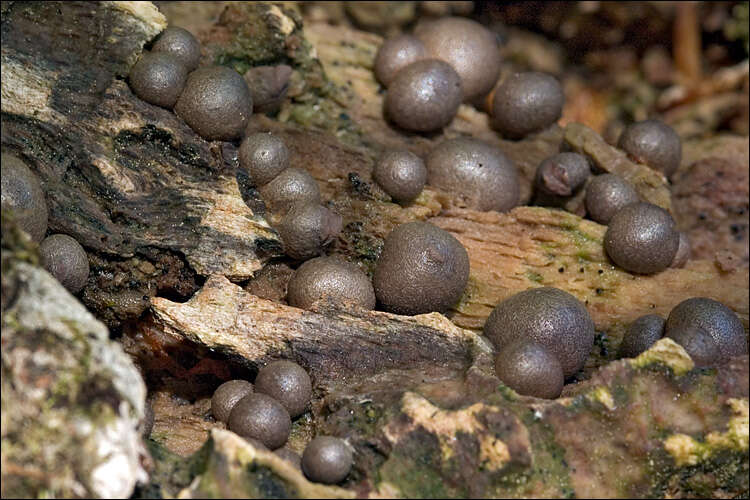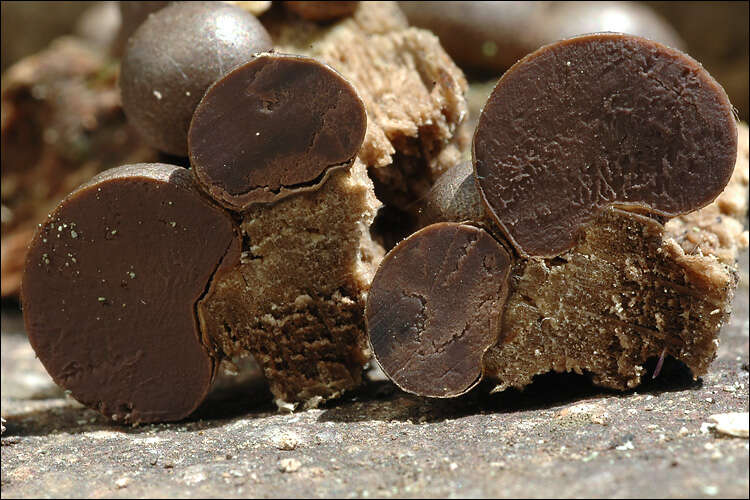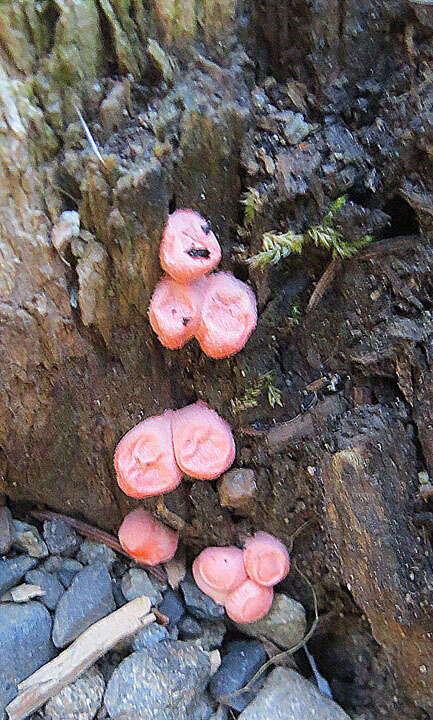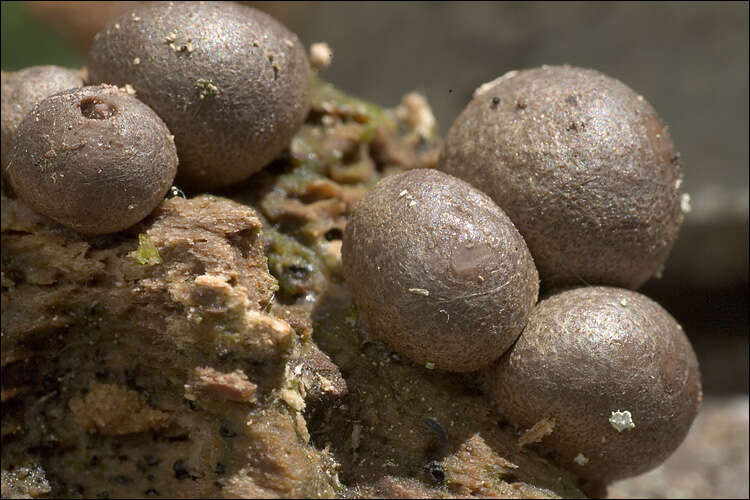-
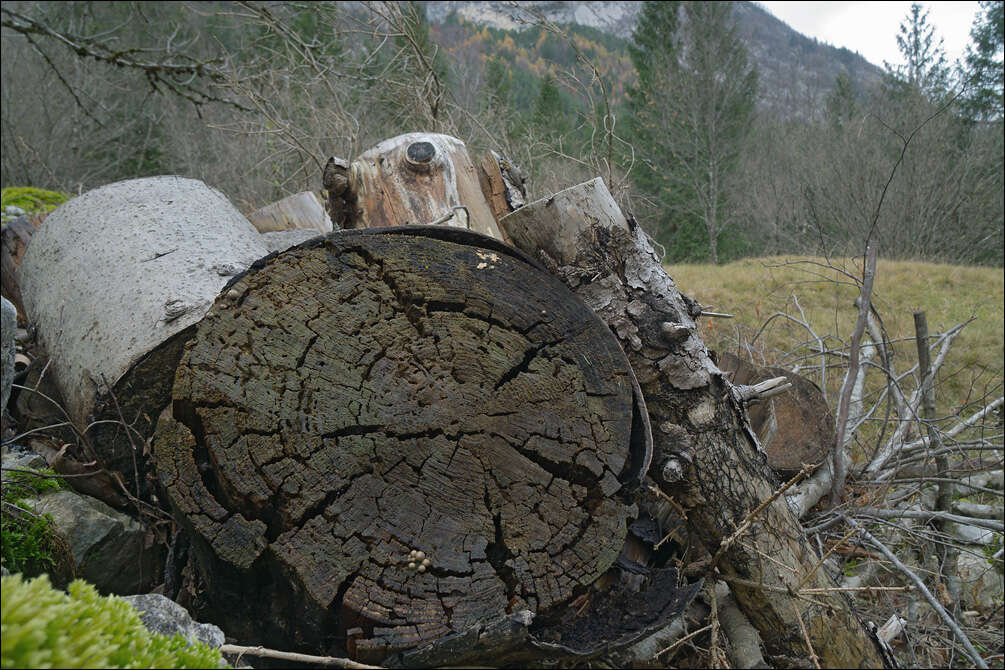
Lycogala epidendrum (L.) Fr.Wolf's Milk, Groening's Slime, DE: BlutmilchpilzSlo.: razbarvana grahovkaDat.: Nov. 9. 2017Lat.: 46.36014 Long.: 13.70435Code: Bot_1096/2017_DSC9621Picture file names: from Lycogala-epidendrum_raw_20 to Lycogala-epidendrum_raw_24.Habitat: mountain pasture; slightly inclined terrain, southeast aspect; colluvial/glacial, calcareous ground; full sun, dry place; elevation 575 m (1.900 feet); average precipitations ~ 3.000 mm/year, average temperature 7-9 deg C, alpine phytogeographical region. Substratum: a pile of partly rotten stump of Picea abies, mostly still in bark.Place: Lower Trenta valley, right bank of river Soa; between villages Soa and Trenta; near Trenta 2 farm house, East Julian Alps, Posoje, Slovenia EC.Comment: Average diameter of seven aethalia found was somewhat small (AVG = 4.5 mm, SD = 0.6 mm) compared to data from literature (the smallest had only 2.2 mm in diameter); however all other macroscopic traits fit well to Lycogala epidendrum species descriptions. Microscopically spore dimensions, their shape and reticulated surface, all fit to this species. Also pseudocapillitium diameter, its surface with conspicuous transverse faults and its club shaped free ends fit well. Spore mass grayish with pink tint. Spores reticulated, globose to subglobose. Dimensions: (6,7) 7 - 7,5 (7,9) x (6,5) 6,8 - 7,3 (7,5) microns; Q = 1 - 1,06 (1,1); N = 35; Me = 7,3 x 7,1 microns; Qe = 1. Olympus CH20, NEA 100x/1.25, magnification 1.000 x, oil (spores), NEA 40x/0.65, magnification 400x (pseudocapillitium), NEA 10x/0.25, magnification 100x (pseudocapillitium); in water; fresh material. AmScope MA500 digital camera.Ref.:(1) B. Ing, The Myxomycetes of Britain and Ireland,The Richmond Publ. Co.Ltd, (1999), p 91. (2) S.L.Stephenson and H.Stempen, Myxomycetes, Timber Press Inc.(2000), p 135. (3) M. Poulain, M. Meyer, J. Borronet, Les Myxomycetes, FMBDS (2011), Vol.1., p 321; Vol.2. p 75. (4) S. Behri, Raznolikost Pravih Sluzavk (Myxomycetes) v okolici Mengea, (in Slovene) (True Slime Molds (Myxomicetes) Diversity in Vicinity of Menge) (in Slovene), Graduation Thesis, University Studies, University in Ljubljana, Biotechnical Faculty, Biology department (2015), p 74. Baumann - H. Marx, Die Myxomyceten Deutschlands und des angrenzenden Alpenraumes unter besonderen Bercksichtigung sterreichs, Vol.1., Karlheinz Baumann Verlag, (1993, 1995, 2000), p 135.
-
Lycogala epidendrumSlo.: razbarvana grahovkaDate: June 13. 2009Lat.: 46.33439 Long.: 13.48114Code: Bot_354/2009-0083Habitat: Mixed, predominantly Fagus sylvatica forest, in shade, partly protected from direct rain by tree canopies, precipitations ~3.000 mm/year, average temperature 3 -5 deg C, elevation 1.330 m (4.400 feet), alpine phytogeographical region.Substratum: fallen, heavily rotted trunk of an unknown deciduous tree Place: Gozdec forest, above the road from Mt.Kanin cable car station B to the foot of Mt. Kopa, East Julian Alps, Posoje, Slovenia EC
-
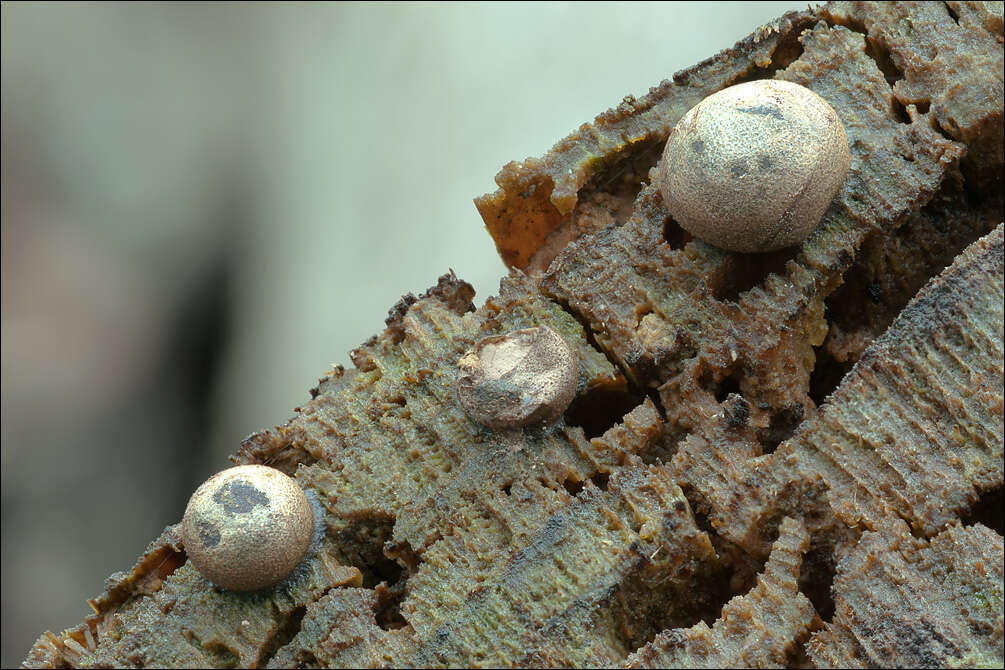
Lycogala epidendrum (L.) Fr.Wolf's Milk, Groening's Slime, DE: BlutmilchpilzSlo.: razbarvana grahovkaDat.: Nov. 9. 2017Lat.: 46.36014 Long.: 13.70435Code: Bot_1096/2017_DSC9621Picture file names: from Lycogala-epidendrum_raw_20 to Lycogala-epidendrum_raw_24.Habitat: mountain pasture; slightly inclined terrain, southeast aspect; colluvial/glacial, calcareous ground; full sun, dry place; elevation 575 m (1.900 feet); average precipitations ~ 3.000 mm/year, average temperature 7-9 deg C, alpine phytogeographical region. Substratum: a pile of partly rotten stump of Picea abies, mostly still in bark.Place: Lower Trenta valley, right bank of river Soa; between villages Soa and Trenta; near Trenta 2 farm house, East Julian Alps, Posoje, Slovenia EC.Comment: Average diameter of seven aethalia found was somewhat small (AVG = 4.5 mm, SD = 0.6 mm) compared to data from literature (the smallest had only 2.2 mm in diameter); however all other macroscopic traits fit well to Lycogala epidendrum species descriptions. Microscopically spore dimensions, their shape and reticulated surface, all fit to this species. Also pseudocapillitium diameter, its surface with conspicuous transverse faults and its club shaped free ends fit well. Spore mass grayish with pink tint. Spores reticulated, globose to subglobose. Dimensions: (6,7) 7 - 7,5 (7,9) x (6,5) 6,8 - 7,3 (7,5) microns; Q = 1 - 1,06 (1,1); N = 35; Me = 7,3 x 7,1 microns; Qe = 1. Olympus CH20, NEA 100x/1.25, magnification 1.000 x, oil (spores), NEA 40x/0.65, magnification 400x (pseudocapillitium), NEA 10x/0.25, magnification 100x (pseudocapillitium); in water; fresh material. AmScope MA500 digital camera.Ref.:(1) B. Ing, The Myxomycetes of Britain and Ireland,The Richmond Publ. Co.Ltd, (1999), p 91. (2) S.L.Stephenson and H.Stempen, Myxomycetes, Timber Press Inc.(2000), p 135. (3) M. Poulain, M. Meyer, J. Borronet, Les Myxomycetes, FMBDS (2011), Vol.1., p 321; Vol.2. p 75. (4) S. Behri, Raznolikost Pravih Sluzavk (Myxomycetes) v okolici Mengea, (in Slovene) (True Slime Molds (Myxomicetes) Diversity in Vicinity of Menge) (in Slovene), Graduation Thesis, University Studies, University in Ljubljana, Biotechnical Faculty, Biology department (2015), p 74. Baumann - H. Marx, Die Myxomyceten Deutschlands und des angrenzenden Alpenraumes unter besonderen Bercksichtigung sterreichs, Vol.1., Karlheinz Baumann Verlag, (1993, 1995, 2000), p 135.
-
Lycogala epidendrumSlo.: razbarvana grahovkaDate: June 13. 2009Lat.: 46.33439 Long.: 13.48114Code: Bot_354/2009-0083Habitat: Mixed, predominantly Fagus sylvatica forest, in shade, partly protected from direct rain by tree canopies, precipitations ~3.000 mm/year, average temperature 3 -5 deg C, elevation 1.330 m (4.400 feet), alpine phytogeographical region.Substratum: fallen, heavily rotted trunk of an unknown deciduous tree Place: Gozdec forest, above the road from Mt.Kanin cable car station B to the foot of Mt. Kopa, East Julian Alps, Posoje, Slovenia EC
-
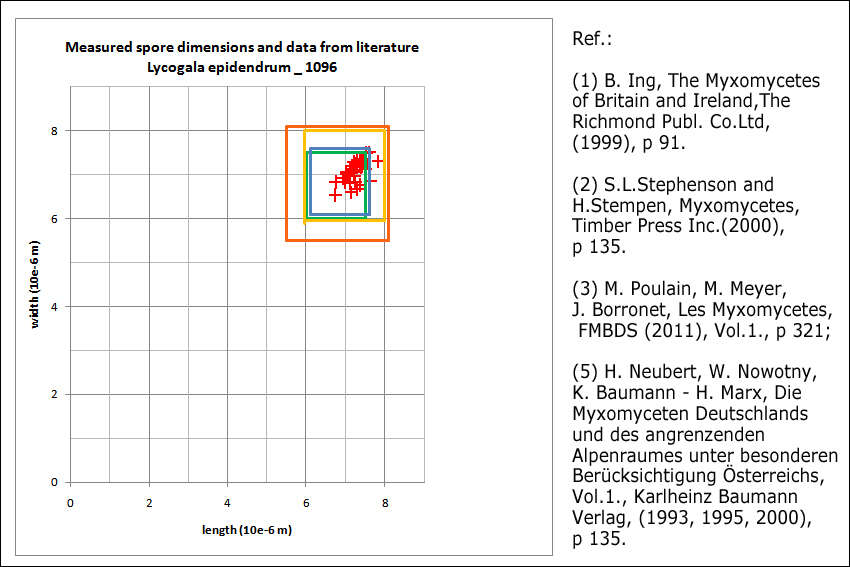
Lycogala epidendrum (L.) Fr.Wolf's Milk, Groening's Slime, DE: BlutmilchpilzSlo.: razbarvana grahovkaDat.: Nov. 9. 2017Lat.: 46.36014 Long.: 13.70435Code: Bot_1096/2017_DSC9621Picture file names: from Lycogala-epidendrum_raw_20 to Lycogala-epidendrum_raw_24.Habitat: mountain pasture; slightly inclined terrain, southeast aspect; colluvial/glacial, calcareous ground; full sun, dry place; elevation 575 m (1.900 feet); average precipitations ~ 3.000 mm/year, average temperature 7-9 deg C, alpine phytogeographical region. Substratum: a pile of partly rotten stump of Picea abies, mostly still in bark.Place: Lower Trenta valley, right bank of river Soa; between villages Soa and Trenta; near Trenta 2 farm house, East Julian Alps, Posoje, Slovenia EC.Comment: Average diameter of seven aethalia found was somewhat small (AVG = 4.5 mm, SD = 0.6 mm) compared to data from literature (the smallest had only 2.2 mm in diameter); however all other macroscopic traits fit well to Lycogala epidendrum species descriptions. Microscopically spore dimensions, their shape and reticulated surface, all fit to this species. Also pseudocapillitium diameter, its surface with conspicuous transverse faults and its club shaped free ends fit well. Spore mass grayish with pink tint. Spores reticulated, globose to subglobose. Dimensions: (6,7) 7 - 7,5 (7,9) x (6,5) 6,8 - 7,3 (7,5) microns; Q = 1 - 1,06 (1,1); N = 35; Me = 7,3 x 7,1 microns; Qe = 1. Olympus CH20, NEA 100x/1.25, magnification 1.000 x, oil (spores), NEA 40x/0.65, magnification 400x (pseudocapillitium), NEA 10x/0.25, magnification 100x (pseudocapillitium); in water; fresh material. AmScope MA500 digital camera.Ref.:(1) B. Ing, The Myxomycetes of Britain and Ireland,The Richmond Publ. Co.Ltd, (1999), p 91. (2) S.L.Stephenson and H.Stempen, Myxomycetes, Timber Press Inc.(2000), p 135. (3) M. Poulain, M. Meyer, J. Borronet, Les Myxomycetes, FMBDS (2011), Vol.1., p 321; Vol.2. p 75. (4) S. Behri, Raznolikost Pravih Sluzavk (Myxomycetes) v okolici Mengea, (in Slovene) (True Slime Molds (Myxomicetes) Diversity in Vicinity of Menge) (in Slovene), Graduation Thesis, University Studies, University in Ljubljana, Biotechnical Faculty, Biology department (2015), p 74. Baumann - H. Marx, Die Myxomyceten Deutschlands und des angrenzenden Alpenraumes unter besonderen Bercksichtigung sterreichs, Vol.1., Karlheinz Baumann Verlag, (1993, 1995, 2000), p 135.
-
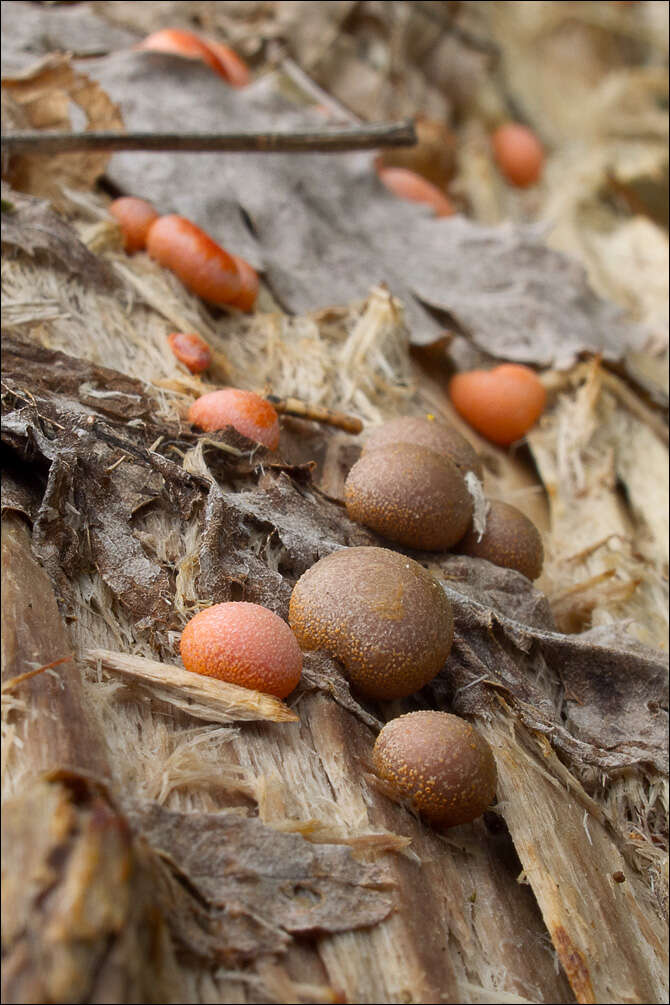
Lycogala epidendrum (L.) Fr.Wolf's Milk, Groening's Slime, DE: BlutmilchpilzSlo.: razbarvana grahovkaDat.: Apr. 21. 2013Lat.: 46.33573 Long.: 13.56734Code: Bot_705/2013_IMG3014Habitat: Light, mixed, predominantly hardwood woodland with some Picea abies, moderately steep, south-west oriented hill side, cretaceous clastic rock (flysh), partly protected from direct rain by tree canopies, mostly in shade, average precipitations ~3.000 mm/year, average temperature 8-10 deg C, elevation 480 m (1.575 feet), alpine phytogeographical region.Substratum: dead trunk of deciduous tree lying on ground and in its final phase of disintegration.Place: Bovec basin, southwest slope of the hill Rabeljnik, East Julian Alps, Posoje, Slovenia EC. Comment: Lycogala epidendrum is one of the most common and most easy to spot Myxomicete in the upper Soa river region. Immature aethalia are vividly orange and distinctly pop out from surrounding decaying wood. Contrary to this gray-brown mature aethalia blend well with the surrounding and require some effort to be found. Ref.:(1) B. Ing, The Myxomycetes of Britain and Ireland,The Richmond Publ. Co.Ltd, (1999), p 91.(2) S.L.Stephenson and H.Stempen, Myxomycetes, Timber Press Inc.(2000), p 135(3) M. Poulain, M. Meyer, J. Borronet, Les Myxomycetes, FMBDS (2011), Vol.1., p 321; Vol.2. p 75.
-
Lycogala epidendrumSlo.: razbarvana grahovkaDate: June 13. 2009Lat.: 46.33439 Long.: 13.48114Code: Bot_354/2009-0083Habitat: Mixed, predominantly Fagus sylvatica forest, in shade, partly protected from direct rain by tree canopies, precipitations ~3.000 mm/year, average temperature 3 -5 deg C, elevation 1.330 m (4.400 feet), alpine phytogeographical region.Substratum: fallen, heavily rotted trunk of an unknown deciduous tree Place: Gozdec forest, above the road from Mt.Kanin cable car station B to the foot of Mt. Kopa, East Julian Alps, Posoje, Slovenia EC
-
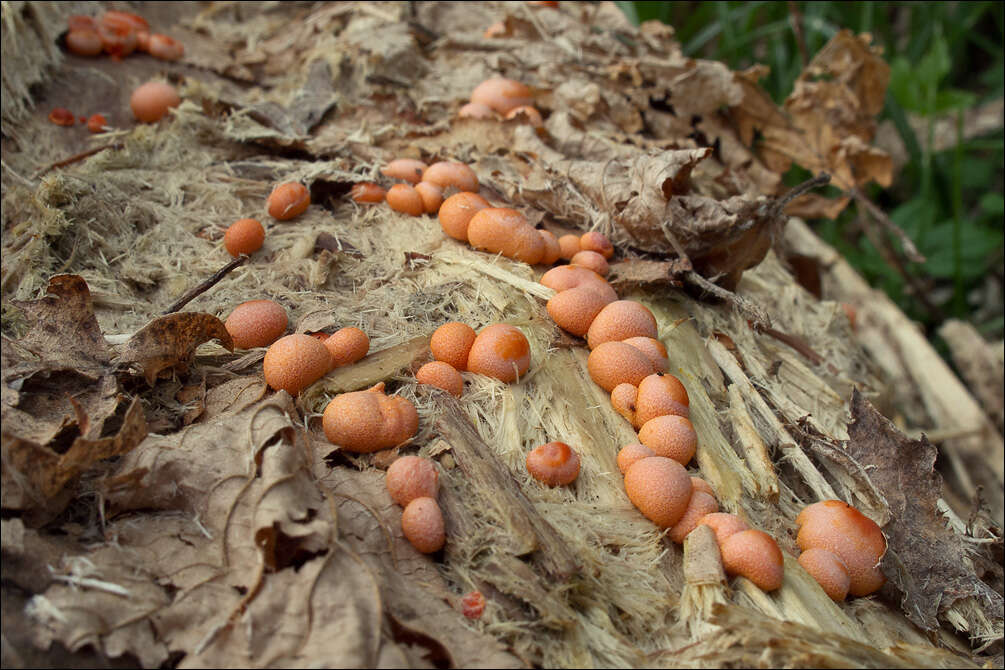
Lycogala epidendrum (L.) Fr.Wolf's Milk, Groening's Slime, DE: BlutmilchpilzSlo.: razbarvana grahovkaDat.: Apr. 21. 2013Lat.: 46.33573 Long.: 13.56734Code: Bot_705/2013_IMG3014Habitat: Light, mixed, predominantly hardwood woodland with some Picea abies, moderately steep, south-west oriented hill side, cretaceous clastic rock (flysh), partly protected from direct rain by tree canopies, mostly in shade, average precipitations ~3.000 mm/year, average temperature 8-10 deg C, elevation 480 m (1.575 feet), alpine phytogeographical region.Substratum: dead trunk of deciduous tree lying on ground and in its final phase of disintegration.Place: Bovec basin, southwest slope of the hill Rabeljnik, East Julian Alps, Posoje, Slovenia EC. Comment: Lycogala epidendrum is one of the most common and most easy to spot Myxomicete in the upper Soa river region. Immature aethalia are vividly orange and distinctly pop out from surrounding decaying wood. Contrary to this gray-brown mature aethalia blend well with the surrounding and require some effort to be found. Ref.:(1) B. Ing, The Myxomycetes of Britain and Ireland,The Richmond Publ. Co.Ltd, (1999), p 91.(2) S.L.Stephenson and H.Stempen, Myxomycetes, Timber Press Inc.(2000), p 135(3) M. Poulain, M. Meyer, J. Borronet, Les Myxomycetes, FMBDS (2011), Vol.1., p 321; Vol.2. p 75.
-
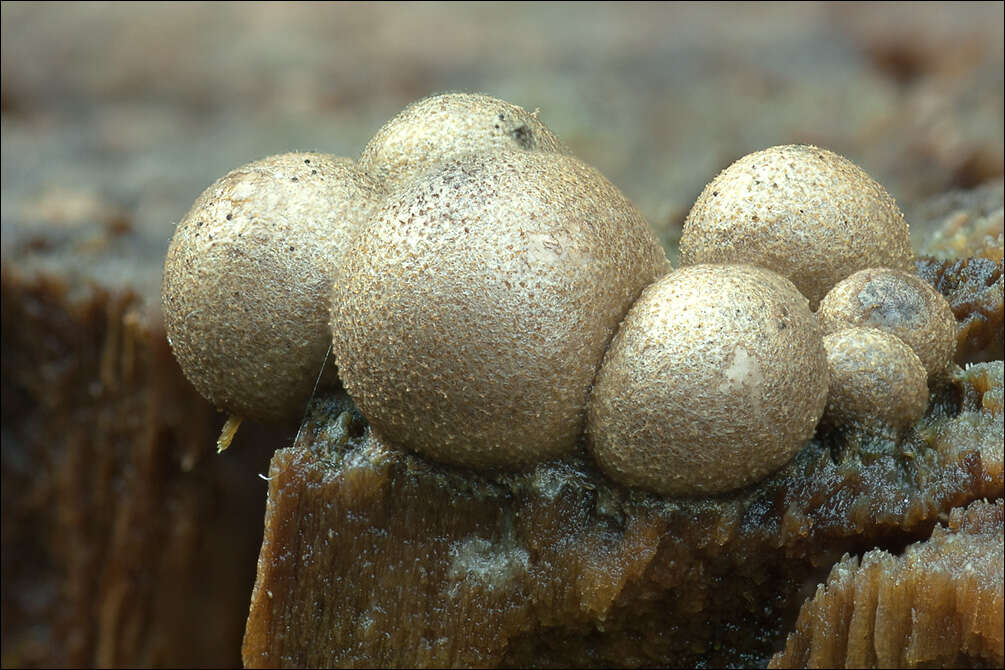
Lycogala epidendrum (L.) Fr.Wolf's Milk, Groening's Slime, DE: BlutmilchpilzSlo.: razbarvana grahovkaDat.: Nov. 9. 2017Lat.: 46.36014 Long.: 13.70435Code: Bot_1096/2017_DSC9621Picture file names: from Lycogala-epidendrum_raw_20 to Lycogala-epidendrum_raw_24.Habitat: mountain pasture; slightly inclined terrain, southeast aspect; colluvial/glacial, calcareous ground; full sun, dry place; elevation 575 m (1.900 feet); average precipitations ~ 3.000 mm/year, average temperature 7-9 deg C, alpine phytogeographical region. Substratum: a pile of partly rotten stump of Picea abies, mostly still in bark.Place: Lower Trenta valley, right bank of river Soa; between villages Soa and Trenta; near Trenta 2 farm house, East Julian Alps, Posoje, Slovenia EC.Comment: Average diameter of seven aethalia found was somewhat small (AVG = 4.5 mm, SD = 0.6 mm) compared to data from literature (the smallest had only 2.2 mm in diameter); however all other macroscopic traits fit well to Lycogala epidendrum species descriptions. Microscopically spore dimensions, their shape and reticulated surface, all fit to this species. Also pseudocapillitium diameter, its surface with conspicuous transverse faults and its club shaped free ends fit well. Spore mass grayish with pink tint. Spores reticulated, globose to subglobose. Dimensions: (6,7) 7 - 7,5 (7,9) x (6,5) 6,8 - 7,3 (7,5) microns; Q = 1 - 1,06 (1,1); N = 35; Me = 7,3 x 7,1 microns; Qe = 1. Olympus CH20, NEA 100x/1.25, magnification 1.000 x, oil (spores), NEA 40x/0.65, magnification 400x (pseudocapillitium), NEA 10x/0.25, magnification 100x (pseudocapillitium); in water; fresh material. AmScope MA500 digital camera.Ref.:(1) B. Ing, The Myxomycetes of Britain and Ireland,The Richmond Publ. Co.Ltd, (1999), p 91. (2) S.L.Stephenson and H.Stempen, Myxomycetes, Timber Press Inc.(2000), p 135. (3) M. Poulain, M. Meyer, J. Borronet, Les Myxomycetes, FMBDS (2011), Vol.1., p 321; Vol.2. p 75. (4) S. Behri, Raznolikost Pravih Sluzavk (Myxomycetes) v okolici Mengea, (in Slovene) (True Slime Molds (Myxomicetes) Diversity in Vicinity of Menge) (in Slovene), Graduation Thesis, University Studies, University in Ljubljana, Biotechnical Faculty, Biology department (2015), p 74. Baumann - H. Marx, Die Myxomyceten Deutschlands und des angrenzenden Alpenraumes unter besonderen Bercksichtigung sterreichs, Vol.1., Karlheinz Baumann Verlag, (1993, 1995, 2000), p 135.
-
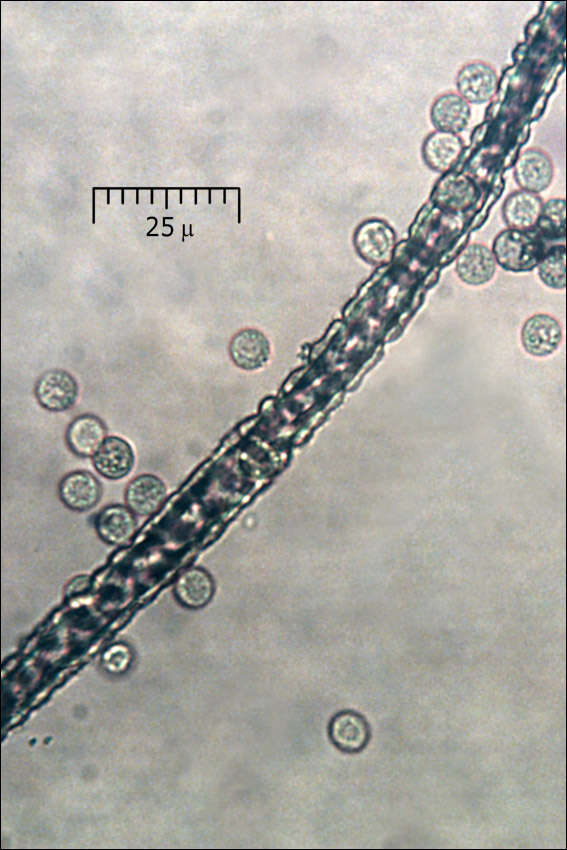
Lycogala epidendrum (L.) Fr.Wolf's Milk, Groening's Slime, DE: BlutmilchpilzSlo.: razbarvana grahovkaDat.: Nov. 9. 2017Lat.: 46.36014 Long.: 13.70435Code: Bot_1096/2017_DSC9621Picture file names: from Lycogala-epidendrum_raw_20 to Lycogala-epidendrum_raw_24.Habitat: mountain pasture; slightly inclined terrain, southeast aspect; colluvial/glacial, calcareous ground; full sun, dry place; elevation 575 m (1.900 feet); average precipitations ~ 3.000 mm/year, average temperature 7-9 deg C, alpine phytogeographical region. Substratum: a pile of partly rotten stump of Picea abies, mostly still in bark.Place: Lower Trenta valley, right bank of river Soa; between villages Soa and Trenta; near Trenta 2 farm house, East Julian Alps, Posoje, Slovenia EC.Comment: Average diameter of seven aethalia found was somewhat small (AVG = 4.5 mm, SD = 0.6 mm) compared to data from literature (the smallest had only 2.2 mm in diameter); however all other macroscopic traits fit well to Lycogala epidendrum species descriptions. Microscopically spore dimensions, their shape and reticulated surface, all fit to this species. Also pseudocapillitium diameter, its surface with conspicuous transverse faults and its club shaped free ends fit well. Spore mass grayish with pink tint. Spores reticulated, globose to subglobose. Dimensions: (6,7) 7 - 7,5 (7,9) x (6,5) 6,8 - 7,3 (7,5) microns; Q = 1 - 1,06 (1,1); N = 35; Me = 7,3 x 7,1 microns; Qe = 1. Olympus CH20, NEA 100x/1.25, magnification 1.000 x, oil (spores), NEA 40x/0.65, magnification 400x (pseudocapillitium), NEA 10x/0.25, magnification 100x (pseudocapillitium); in water; fresh material. AmScope MA500 digital camera.Ref.:(1) B. Ing, The Myxomycetes of Britain and Ireland,The Richmond Publ. Co.Ltd, (1999), p 91. (2) S.L.Stephenson and H.Stempen, Myxomycetes, Timber Press Inc.(2000), p 135. (3) M. Poulain, M. Meyer, J. Borronet, Les Myxomycetes, FMBDS (2011), Vol.1., p 321; Vol.2. p 75. (4) S. Behri, Raznolikost Pravih Sluzavk (Myxomycetes) v okolici Mengea, (in Slovene) (True Slime Molds (Myxomicetes) Diversity in Vicinity of Menge) (in Slovene), Graduation Thesis, University Studies, University in Ljubljana, Biotechnical Faculty, Biology department (2015), p 74. Baumann - H. Marx, Die Myxomyceten Deutschlands und des angrenzenden Alpenraumes unter besonderen Bercksichtigung sterreichs, Vol.1., Karlheinz Baumann Verlag, (1993, 1995, 2000), p 135.
-

Lycogala epidendrum (L.) Fr.Wolf's Milk, Groening's Slime, DE: BlutmilchpilzSlo.: razbarvana grahovkaDat.: Apr. 21. 2013Lat.: 46.33573 Long.: 13.56734Code: Bot_705/2013_IMG3014Habitat: Light, mixed, predominantly hardwood woodland with some Picea abies, moderately steep, south-west oriented hill side, cretaceous clastic rock (flysh), partly protected from direct rain by tree canopies, mostly in shade, average precipitations ~3.000 mm/year, average temperature 8-10 deg C, elevation 480 m (1.575 feet), alpine phytogeographical region.Substratum: dead trunk of deciduous tree lying on ground and in its final phase of disintegration.Place: Bovec basin, southwest slope of the hill Rabeljnik, East Julian Alps, Posoje, Slovenia EC. Comment: Lycogala epidendrum is one of the most common and most easy to spot Myxomicete in the upper Soa river region. Immature aethalia are vividly orange and distinctly pop out from surrounding decaying wood. Contrary to this gray-brown mature aethalia blend well with the surrounding and require some effort to be found. Ref.:(1) B. Ing, The Myxomycetes of Britain and Ireland,The Richmond Publ. Co.Ltd, (1999), p 91.(2) S.L.Stephenson and H.Stempen, Myxomycetes, Timber Press Inc.(2000), p 135(3) M. Poulain, M. Meyer, J. Borronet, Les Myxomycetes, FMBDS (2011), Vol.1., p 321; Vol.2. p 75.
-
Lycogala epidendrumSlo.: razbarvana grahovkaDate: June 13. 2009Lat.: 46.33439 Long.: 13.48114Code: Bot_354/2009-0083Habitat: Mixed, predominantly Fagus sylvatica forest, in shade, partly protected from direct rain by tree canopies, precipitations ~3.000 mm/year, average temperature 3 -5 deg C, elevation 1.330 m (4.400 feet), alpine phytogeographical region.Substratum: fallen, heavily rotted trunk of an unknown deciduous tree Place: Gozdec forest, above the road from Mt.Kanin cable car station B to the foot of Mt. Kopa, East Julian Alps, Posoje, Slovenia EC
-
Lycogala epidendrumSlo.: razbarvana grahovkaDate: June 13. 2009Lat.: 46.33439 Long.: 13.48114Code: Bot_354/2009-0083Habitat: Mixed, predominantly Fagus sylvatica forest, in shade, partly protected from direct rain by tree canopies, precipitations ~3.000 mm/year, average temperature 3 -5 deg C, elevation 1.330 m (4.400 feet), alpine phytogeographical region.Substratum: fallen, heavily rotted trunk of an unknown deciduous tree Place: Gozdec forest, above the road from Mt.Kanin cable car station B to the foot of Mt. Kopa, East Julian Alps, Posoje, Slovenia EC
-

Lycogala epidendrum (L.) Fr.Wolf's Milk, Groening's Slime, DE: BlutmilchpilzSlo.: razbarvana grahovkaDat.: Apr. 21. 2013Lat.: 46.33573 Long.: 13.56734Code: Bot_705/2013_IMG3014Habitat: Light, mixed, predominantly hardwood woodland with some Picea abies, moderately steep, south-west oriented hill side, cretaceous clastic rock (flysh), partly protected from direct rain by tree canopies, mostly in shade, average precipitations ~3.000 mm/year, average temperature 8-10 deg C, elevation 480 m (1.575 feet), alpine phytogeographical region.Substratum: dead trunk of deciduous tree lying on ground and in its final phase of disintegration.Place: Bovec basin, southwest slope of the hill Rabeljnik, East Julian Alps, Posoje, Slovenia EC. Comment: Lycogala epidendrum is one of the most common and most easy to spot Myxomicete in the upper Soa river region. Immature aethalia are vividly orange and distinctly pop out from surrounding decaying wood. Contrary to this gray-brown mature aethalia blend well with the surrounding and require some effort to be found. Ref.:(1) B. Ing, The Myxomycetes of Britain and Ireland,The Richmond Publ. Co.Ltd, (1999), p 91.(2) S.L.Stephenson and H.Stempen, Myxomycetes, Timber Press Inc.(2000), p 135(3) M. Poulain, M. Meyer, J. Borronet, Les Myxomycetes, FMBDS (2011), Vol.1., p 321; Vol.2. p 75.
-
Concentrations of amoeba like protozoa collect to form pink pustules, that turn back into pink slime at a touch. Manning Park, British Columbia. Tubiferaceae Family.
-
Lycogala epidendrumSlo.: razbarvana grahovkaDate: June 13. 2009Lat.: 46.33439 Long.: 13.48114Code: Bot_354/2009-0083Habitat: Mixed, predominantly Fagus sylvatica forest, in shade, partly protected from direct rain by tree canopies, precipitations ~3.000 mm/year, average temperature 3 -5 deg C, elevation 1.330 m (4.400 feet), alpine phytogeographical region.Substratum: fallen, heavily rotted trunk of an unknown deciduous tree Place: Gozdec forest, above the road from Mt.Kanin cable car station B to the foot of Mt. Kopa, East Julian Alps, Posoje, Slovenia EC
-
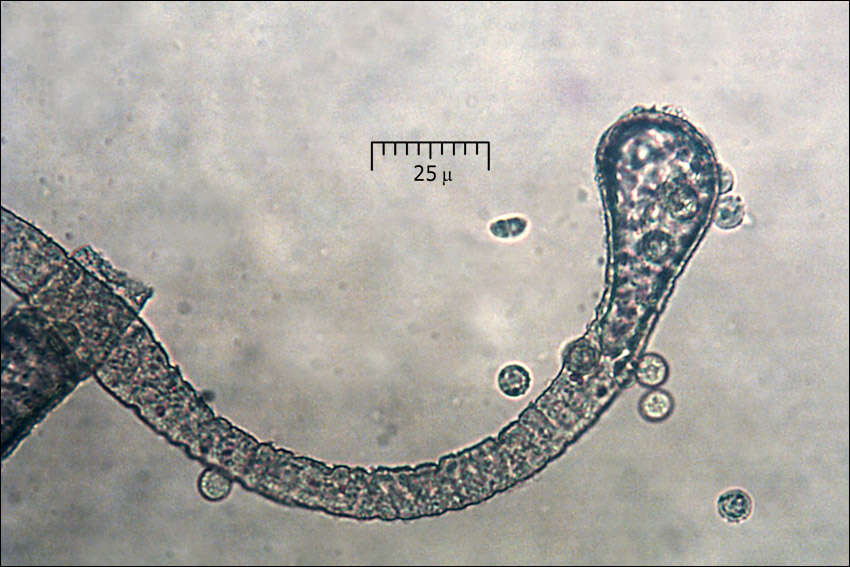
Lycogala epidendrum (L.) Fr.Wolf's Milk, Groening's Slime, DE: BlutmilchpilzSlo.: razbarvana grahovkaDat.: Nov. 9. 2017Lat.: 46.36014 Long.: 13.70435Code: Bot_1096/2017_DSC9621Picture file names: from Lycogala-epidendrum_raw_20 to Lycogala-epidendrum_raw_24.Habitat: mountain pasture; slightly inclined terrain, southeast aspect; colluvial/glacial, calcareous ground; full sun, dry place; elevation 575 m (1.900 feet); average precipitations ~ 3.000 mm/year, average temperature 7-9 deg C, alpine phytogeographical region. Substratum: a pile of partly rotten stump of Picea abies, mostly still in bark.Place: Lower Trenta valley, right bank of river Soa; between villages Soa and Trenta; near Trenta 2 farm house, East Julian Alps, Posoje, Slovenia EC.Comment: Average diameter of seven aethalia found was somewhat small (AVG = 4.5 mm, SD = 0.6 mm) compared to data from literature (the smallest had only 2.2 mm in diameter); however all other macroscopic traits fit well to Lycogala epidendrum species descriptions. Microscopically spore dimensions, their shape and reticulated surface, all fit to this species. Also pseudocapillitium diameter, its surface with conspicuous transverse faults and its club shaped free ends fit well. Spore mass grayish with pink tint. Spores reticulated, globose to subglobose. Dimensions: (6,7) 7 - 7,5 (7,9) x (6,5) 6,8 - 7,3 (7,5) microns; Q = 1 - 1,06 (1,1); N = 35; Me = 7,3 x 7,1 microns; Qe = 1. Olympus CH20, NEA 100x/1.25, magnification 1.000 x, oil (spores), NEA 40x/0.65, magnification 400x (pseudocapillitium), NEA 10x/0.25, magnification 100x (pseudocapillitium); in water; fresh material. AmScope MA500 digital camera.Ref.:(1) B. Ing, The Myxomycetes of Britain and Ireland,The Richmond Publ. Co.Ltd, (1999), p 91. (2) S.L.Stephenson and H.Stempen, Myxomycetes, Timber Press Inc.(2000), p 135. (3) M. Poulain, M. Meyer, J. Borronet, Les Myxomycetes, FMBDS (2011), Vol.1., p 321; Vol.2. p 75. (4) S. Behri, Raznolikost Pravih Sluzavk (Myxomycetes) v okolici Mengea, (in Slovene) (True Slime Molds (Myxomicetes) Diversity in Vicinity of Menge) (in Slovene), Graduation Thesis, University Studies, University in Ljubljana, Biotechnical Faculty, Biology department (2015), p 74. Baumann - H. Marx, Die Myxomyceten Deutschlands und des angrenzenden Alpenraumes unter besonderen Bercksichtigung sterreichs, Vol.1., Karlheinz Baumann Verlag, (1993, 1995, 2000), p 135.
-
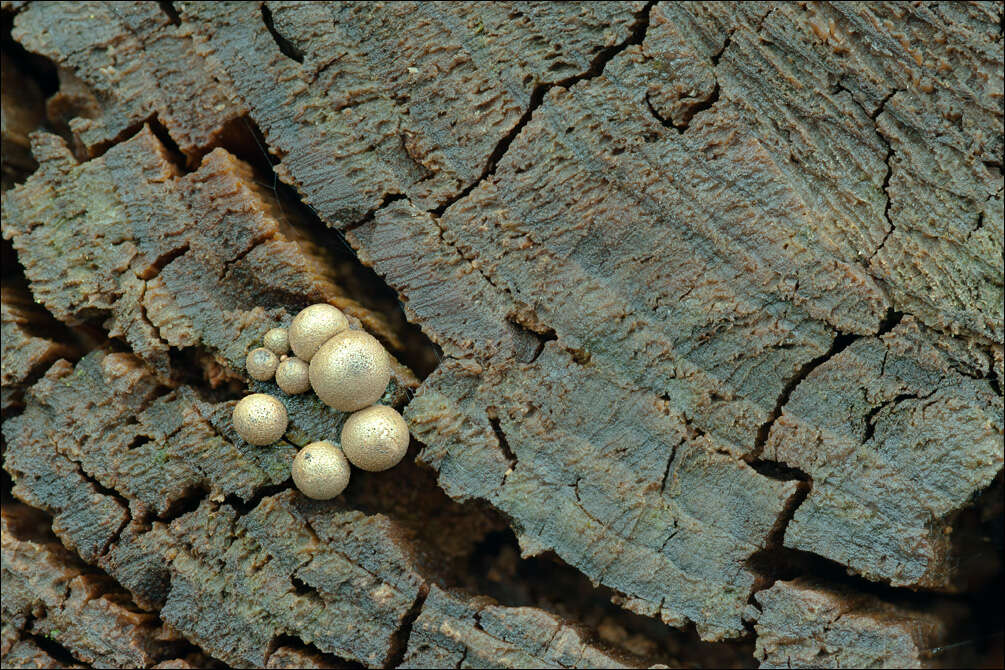
Lycogala epidendrum (L.) Fr.Wolf's Milk, Groening's Slime, DE: BlutmilchpilzSlo.: razbarvana grahovkaDat.: Nov. 9. 2017Lat.: 46.36014 Long.: 13.70435Code: Bot_1096/2017_DSC9621Picture file names: from Lycogala-epidendrum_raw_20 to Lycogala-epidendrum_raw_24.Habitat: mountain pasture; slightly inclined terrain, southeast aspect; colluvial/glacial, calcareous ground; full sun, dry place; elevation 575 m (1.900 feet); average precipitations ~ 3.000 mm/year, average temperature 7-9 deg C, alpine phytogeographical region. Substratum: a pile of partly rotten stump of Picea abies, mostly still in bark.Place: Lower Trenta valley, right bank of river Soa; between villages Soa and Trenta; near Trenta 2 farm house, East Julian Alps, Posoje, Slovenia EC.Comment: Average diameter of seven aethalia found was somewhat small (AVG = 4.5 mm, SD = 0.6 mm) compared to data from literature (the smallest had only 2.2 mm in diameter); however all other macroscopic traits fit well to Lycogala epidendrum species descriptions. Microscopically spore dimensions, their shape and reticulated surface, all fit to this species. Also pseudocapillitium diameter, its surface with conspicuous transverse faults and its club shaped free ends fit well. Spore mass grayish with pink tint. Spores reticulated, globose to subglobose. Dimensions: (6,7) 7 - 7,5 (7,9) x (6,5) 6,8 - 7,3 (7,5) microns; Q = 1 - 1,06 (1,1); N = 35; Me = 7,3 x 7,1 microns; Qe = 1. Olympus CH20, NEA 100x/1.25, magnification 1.000 x, oil (spores), NEA 40x/0.65, magnification 400x (pseudocapillitium), NEA 10x/0.25, magnification 100x (pseudocapillitium); in water; fresh material. AmScope MA500 digital camera.Ref.:(1) B. Ing, The Myxomycetes of Britain and Ireland,The Richmond Publ. Co.Ltd, (1999), p 91. (2) S.L.Stephenson and H.Stempen, Myxomycetes, Timber Press Inc.(2000), p 135. (3) M. Poulain, M. Meyer, J. Borronet, Les Myxomycetes, FMBDS (2011), Vol.1., p 321; Vol.2. p 75. (4) S. Behri, Raznolikost Pravih Sluzavk (Myxomycetes) v okolici Mengea, (in Slovene) (True Slime Molds (Myxomicetes) Diversity in Vicinity of Menge) (in Slovene), Graduation Thesis, University Studies, University in Ljubljana, Biotechnical Faculty, Biology department (2015), p 74. Baumann - H. Marx, Die Myxomyceten Deutschlands und des angrenzenden Alpenraumes unter besonderen Bercksichtigung sterreichs, Vol.1., Karlheinz Baumann Verlag, (1993, 1995, 2000), p 135.


